Related Research Articles

A military band is a group of personnel that performs musical duties for military functions, usually for the armed forces. A typical military band consists mostly of wind and percussion instruments. The conductor of a band commonly bears the title of bandmaster or music director. Ottoman military bands are thought to be the oldest variety of military marching bands in the world, dating from the 13th century.
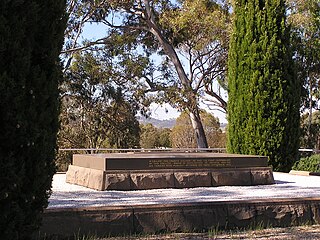
Major General Sir William Throsby Bridges, was a senior Australian Army officer who was instrumental in establishing the Royal Military College, Duntroon and who served as the first Australian Chief of the General Staff. During the First World War he commanded the 1st Australian Division at Gallipoli, where he died of wounds on 18 May 1915, becoming the first Australian general officer to be killed during the war. He was the first Australian officer—and the first graduate of Kingston—to reach the rank of major general, the first to command a division, and the first to receive a knighthood. He is one of only two Australians killed in action in the Great War to be interred in Australia.

Trooping the Colour is a ceremonial event performed every year on Horse Guards Parade in London, United Kingdom, by regiments of Household Division, to celebrate the official birthday of the British sovereign. It is also known as the Sovereign's Birthday Parade. Similar events are held in other countries of the Commonwealth. In the UK, it is, with the State Opening of Parliament, the biggest event of the ceremonial calendar, and watched by millions on TV and on the streets of London.

The Royal Military College, Duntroon, also known simply as Duntroon, is the Australian Army's officer training establishment. It was founded at Duntroon, in Canberra, Australian Capital Territory, in 1911 and is at the foot of Mount Pleasant near Lake Burley Griffin, close to the Department of Defence headquarters at Russell Hill. Duntroon is adjacent to the Australian Defence Force Academy (ADFA), which is Australian Defence Force's tri-service military academy that provides military and tertiary academic education for junior officers of the Australian Army, Royal Australian Air Force and the Royal Australian Navy.
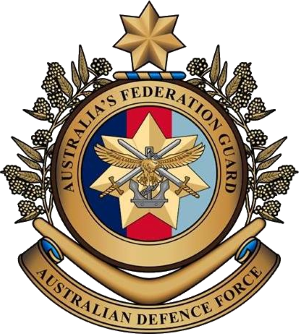
Australia's Federation Guard (AFG) is a tri-service ceremonial unit made up of members from the Royal Australian Navy, Australian Army, and Royal Australian Air Force. Formed in 2000 for the centenary celebrations of Federation of Australia, it is the first purely ceremonial unit in the history of the Australian armed forces, and has since represented Australia in various roles both at home and around the world, including providing the Queen's Guard at Buckingham Palace in 2000.

Beating Retreat is a military ceremony dating to 17th-century England and was first used to recall nearby patrolling units to their castle.

The Officer Cadet School, Portsea was an officer training establishment of the Australian Army. Established at Portsea in Victoria, Australia, in 1951 to provide training to officer cadets prior to commissioning, for many years OCS provided the Australian Regular Army with the bulk of its junior officers. However, following a review of military training establishments in Australia in the mid-1980s, the school was eventually closed in 1985, as the Royal Military College, Duntroon, assumed sole responsibility for training Army officers.

The Australian Defence Force Academy (ADFA) is a tri-service military Academy that provides military and academic education for junior officers of the Australian Defence Force in the Royal Australian Navy (RAN), Australian Army and Royal Australian Air Force (RAAF). In 2016 the Academy began accepting civilian students in its undergraduate courses.
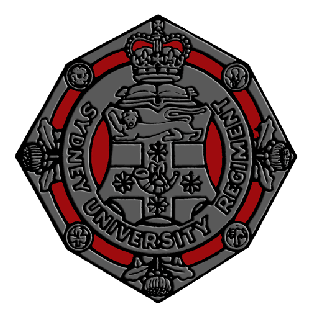
Sydney University Regiment (SUR) is an officer-training regiment of the Australian Army Reserve. Its predecessor, the University Volunteer Rifle Corps, was raised in 1900 as a unit of the colonial New South Wales Defence Force. During the 20th century, several changes of name and role occurred. Sydney University Regiment is headquartered in Holsworthy Barracks and has detachments in Sydney, Canberra and Wollongong.
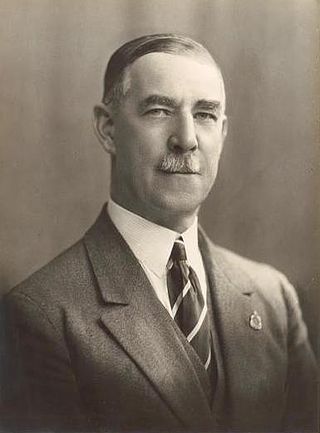
Eric Fairweather Harrison was an Australian soldier and politician.
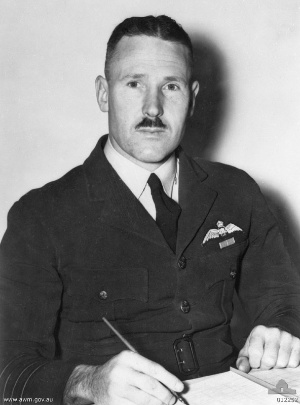
Air Marshal Sir Valston Eldridge Hancock, was a senior commander in the Royal Australian Air Force (RAAF). He served as Chief of the Air Staff from 1961 to 1965. A graduate of the Royal Military College, Duntroon, Hancock transferred from the Army to the RAAF in 1929 and qualified as a pilot. His administrative training at Duntroon saw him mainly occupy staff posts, including Deputy Director of Operations and Intelligence at RAAF Headquarters from 1931 to 1935, and Director of Works and Buildings from 1937 to 1939. During the early years of World War II, he commanded No. 1 Bombing and Gunnery School, and held senior planning and administrative positions. He eventually saw combat in the Aitape–Wewak campaign of the Pacific War during 1945. Flying Bristol Beaufort light bombers, he led first No. 100 Squadron, and later No. 71 Wing. His actions earned him the Distinguished Flying Cross.

Air Marshal Sir Alister Murray Murdoch, was a senior commander in the Royal Australian Air Force (RAAF). He served as Chief of the Air Staff (CAS) from 1965 to 1969. Joining the Air Force in 1930, Murdoch trained as a seaplane pilot and participated in an Antarctic rescue mission for lost explorers in 1935. During World War II, he commanded No. 221 Squadron RAF in Europe and the Middle East, and later occupied senior positions on the staff of RAAF formations in the South West Pacific. His post-war appointments included Commandant of RAAF College from 1952 to 1953, Air Officer Commanding (AOC) Training Command from 1953 to 1955, Deputy Chief of the Air Staff from 1958 to 1959, and AOC Operational Command from 1962 to 1965.

The Royal Military College of Canada Bands is the official group of bands of the Royal Military College of Canada. The group is composed of four sections: the brass and reed, the pipes and drums, highland dancers, and choristers. Total band membership consists of 105 Officer Cadets from the college. Officer Cadets in the band practice three days a week in the morning on top of attending their individual full-time university programs.

The Corps of Staff Cadets (CSC) is a corps of the Australian Army. It is ranked first in the Order of Precedence ahead of the Royal Australian Armoured Corps. The CSC is the corps to which all officer trainees, known as staff cadets, who attend the Royal Military College, Duntroon are allocated once they have completed their initial stage of training in III Class, known as Initial Cadet Training. Upon completion of this training, which lasts between six and eight weeks, the successful III Class cadets are welcomed into the Corps and presented with their Corps lanyard at what is known as the "Lanyard Parade". The name of the Corps of Staff Cadets is derived from the earliest history of the College, which was set up in 1911 to train officers to fill positions in the now defunct Staff Corps. Currently, however, following graduation, the cadet is promoted to the rank of lieutenant and allocated to a combat, combat support or combat service support corps, such as the Royal Australian Infantry Corps, Royal Australian Engineers, Royal Australian Armoured Corps, Royal Australian Corps of Transport, Royal Australian Artillery, etc.

The Royal Canadian Artillery Band is one of six Regular Force bands in the Canadian Armed Forces. Located at Canadian Forces Base Edmonton, the RCA Band provides music designed to support Canadian Forces operations, foster morale and esprit de corps, and promote Canada and the Canadian military nationally and abroad. The band operates mainly in western Canada and is de facto the representative band of the Canadian Army in the western provinces. All unit members are professional musicians in addition to being members of the military, which enables the band to adopt a variety of configurations to suit the musical needs of their audiences. Ensembles can range from jazz combos, rock bands, and chamber groups, through stage and show bands to full marching and concert bands.
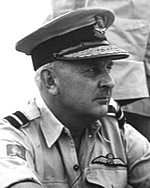
Air Vice Marshal Alan Moorehouse Charlesworth, CBE, AFC was a senior commander in the Royal Australian Air Force (RAAF). Born in Tasmania, he graduated from the Royal Military College, Duntroon, and served with the 2nd Light Horse Regiment in Queensland before transferring to the Air Force in 1925. Most of his pre-war flying career was spent with No. 1 Squadron at RAAF Station Laverton, Victoria. In 1932 he undertook a series of survey flights around Australia, earning the Air Force Cross. Charlesworth's early wartime commands included No. 2 Squadron at Laverton, and RAAF Station Pearce in Western Australia. Appointed Air Officer Commanding (AOC) Eastern Area in December 1943, he was promoted temporary air commodore the following year and took over as AOC North-Western Area in Darwin, Northern Territory.

Canadian military bands are a group of personnel in the Canadian Armed Forces (CAF) that performs musical duties for military functions. Military bands form a part of the Music Branch of the CAF, composed of six full-time professional Regular Force bands, 15 Regular Force voluntary bands, and 53 part-time reserve force bands. Bands of the Music Branch are often badged with the unit or Canadian Forces base insignia that they support.
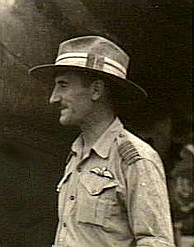
Air Vice Marshal William Lloyd Hely, CB, CBE, AFC was a senior commander in the Royal Australian Air Force (RAAF). He graduated from the Royal Military College, Duntroon, in 1930 before transferring to the RAAF as a cadet pilot. Hely came to public attention in 1936–37, first when he crashed on a survey flight in the Northern Territory, and later when he undertook two successful missions to locate missing aircraft in the same vicinity. His rescue efforts earned him the Air Force Cross. After occupying staff positions during the early years of World War II, Hely was appointed Officer Commanding No. 72 Wing in Dutch New Guinea in May 1944. Later that year he formed No. 84 Wing, commanding it during the Bougainville campaign until the end of the Pacific War.
The Royal Australian Air Force Band is the Royal Australian Air Force's official music branch. The current commanding officer is Squadron Leader Daniel Phillips. The Director of Music is Flight Lieutenant Aaron Michael. The Air Force Band's mission is to promote and enhance the image, reputation and culture of the Air Force. The band represents Air Force at significant events in Australia and abroad.
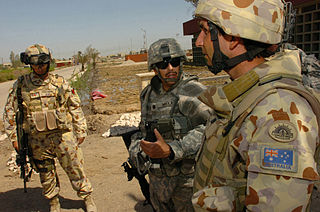
Major General Justin Frederick Ellwood,, commonly known as Jake Ellwood, is a retired senior officer of the Australian Army. He joined the army via the Royal Military College, Duntroon in 1989 and was commissioned into the Royal Australian Infantry Corps. He commanded the 5th Battalion, Royal Australian Regiment (2006–08), Overwatch Battle Group (West) (2007), Battle Group Tiger (2008) and the Combat Training Centre, and deployed on operations to Kosovo, East Timor, Iraq and Afghanistan. He served as Deputy Chief of Army from May to December 2018, and commanded the 1st Division from December 2018 to November 2021.
References
- ↑ "The Band of the Royal Military College". Discogs .
- ↑ "Band of the Royal Military". www.army.gov.au.
- ↑ "Anniversary concert a blast from the past".
- ↑ Coulthard-Clark 1986, p. 83.
- ↑ Coulthard-Clark 1986, p. 189.
- 1 2 "The Band of the Royal Military College, Duntroon". Department of Defence (Australia). Archived from the original on 24 April 2010. Retrieved 24 June 2010.
- ↑ Coulthard-Clark 1986, p.255.
- ↑ "Music at Midday". Canberra Ticketing. Archived from the original on 6 July 2011. Retrieved 2 July 2010.
- ↑ "ACT Honour Walk 2010: Royal Military College (RMC) Duntroon". 3 November 2010. Retrieved 13 October 2012.
- ↑ "The Band of the Royal Military College Presents Marziale".
- ↑ "Band of the Royal Military College strikes a chord for South Coast firefighters". 14 March 2019.
- ↑ Moore, C.A (2004). "The Band of the Royal Military College Duntroon". The Duntroon Society. November (2/2004): 1–4.[ permanent dead link ]
- ↑ "Sun smiles on 2019's mid-year Duntroon graduation". 25 June 2019.
- ↑ "Royal Military College Graduation parade | Governor-General of the Commonwealth of Australia". Archived from the original on 2020-02-17. Retrieved 2020-02-17.
- ↑ "Queen Hails Duntoon as Colours Presented". amp.heraldsun.com.au.
- ↑ "Band of the RMC Duntroon". 18 December 2017.